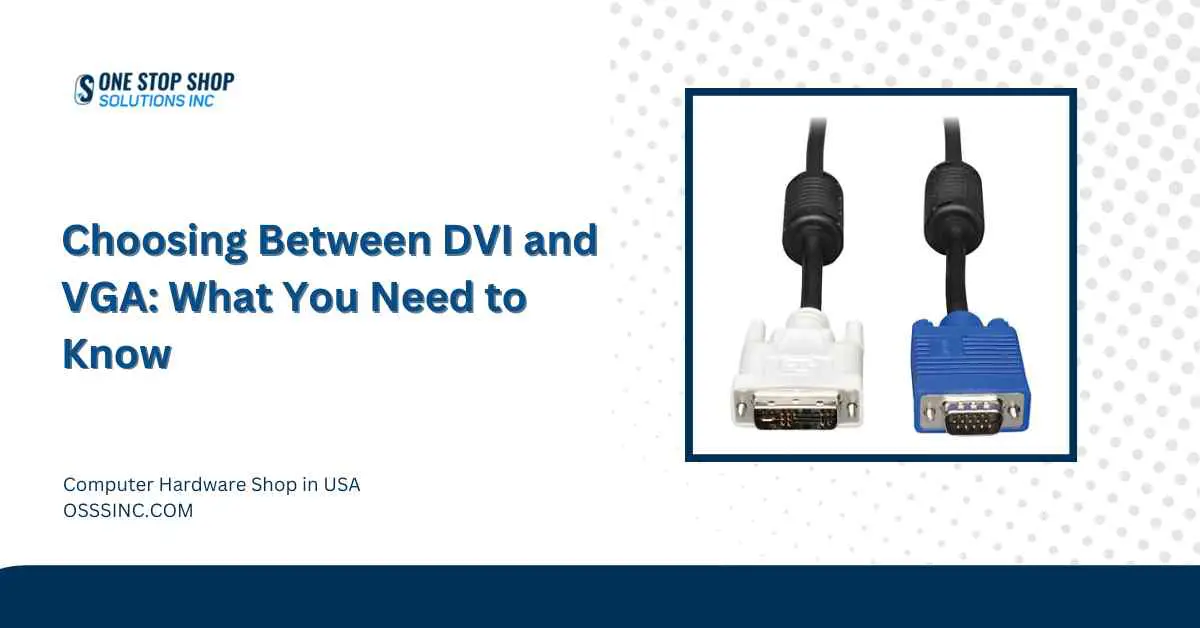DVI vs VGA | What is difference between VGA and DVI Cables Leave a comment
Introduction
When setting up a computer or any other video output device, choosing the right type of cable is essential to ensure you get the best possible display quality. Two common types of video cables are VGA (Video Graphics Array) and DVI (Digital Visual Interface).
So in this article we will discover about the difference between DVI vs VGA, their types and uses to help you chooses the best according to your need.
What is DVI cable ?
DVI, or Digital Visual Interface, was created to be the successor to VGA and has both analog and digital transmission capabilities. DVI’s ability to transfer digital signals directly produces clearer and more precise visuals than analog transmission.
DVI can handle greater resolutions, making it excellent for high-definition monitors and huge display screens. It is compatible with both analog and digital screens and comes in three different configurations (DVI-A, DVI-D, and DVI-I.
Types of DVI Cables
DVI-A: It transmits analog signals and is mostly used for backward compatibility with VGA. It is meant to carry only analog signals. It’s used for connecting to analog display devices. It is not widely utilized because VGA connectors are more widespread for analog connections.
DVI-D: Designed to transmit exclusively digital signals, resulting in clearer and sharper visuals. Available in single-link (up to 1920×1200) and dual-link (up to 2560×1600) configurations. It can be used for high-resolution displays and monitors.
DVI-I: It can carry both digital and analog signals and is the best of the other two connectors. It is also available in both signal and dual link.
What is VGA Cable?
VGA, or Video Graphics Array, is an analog video standard that IBM released in 1987. Despite its age, VGA is still frequently used because of its simplicity and compatibility with older computers and screens.
The typical VGA connector, often known as the DE-15 or HD-15 connector, consists of 15 pins arrayed in three rows. VGA cables send analog signals, which can degrade over long distances.
It is universally compatible with a wide range of older and newer devices, offering it a reliable option for a variety of configurations. In general, VGA cables and connections are less expensive than their digital counterparts. Its analog nature makes it easy to use and robust in a variety of situations.
See more about Types of VGA cables
Difference between VGA and DVI Cable
| Feature | DVI | VGA |
| Signal Type | Digital (with analog support in DVI-I) | Analog |
| Maximum Resolution | Higher (up to 2560×1600 for dual-link) | Lower (up to 2048×1536) |
| Image Quality | Superior, sharper images | Inferior, prone to degradation |
| Specification | Can be hot-plugged, 24/29 pins | Cannot be hot-plugged, 15 pins |
| Compatibility | Newer and older devices (with adapters) | Universally compatible |
| Cost | Moderately expensive | Generally affordable |
| Cable Length | If you need to run a cable for a longer distance, DVI may be more reliable. | Signal deterioration might occur when using VGA cables over extended distances |
| Max Resolution | Up to 2560 x 1600 (Dual Link) | Typically up to 1920 x 1200 |
| Max Refresh Rate | 144Hz (at lower resolutions) | 60Hz (higher resolutions may lower the rate) |
| Bandwidth | Higher | Lower |
| Interference Susceptibility | Lower (digital signals are less prone to interference) | Higher (analog signals are more prone to interference) |
| Connector Types | DVI-A, DVI-D (Single Link and Dual Link), DVI-I (Single Link and Dual Link) | DE-15 (also known as HD-15 or DB-15) |
Conclusion
While VGA has been a dependable standard for many years, DVI provides substantial advances in image quality and resolution support. As technology advances, digital connections like as DVI become more popular, providing improved performance for current screens. Understanding the VGA cable vs DVI can assist you in selecting the optimal cable for your needs, resulting in the finest video experience possible.
FAQs
How can I connect a VGA monitor to a DVI port?
You can connect a VGA monitor to a DVI port using a DVI-I to VGA adapter, which converts the digital signal to an analog one.
Is VGA still relevant in modern displays?
Yes, VGA remains relevant due to its widespread compatibility, especially with older systems and monitors.
Which is better for gaming, DVI or VGA?
DVI is better for gaming because it offers higher resolutions and superior image quality, which are crucial for an optimal gaming experience.



